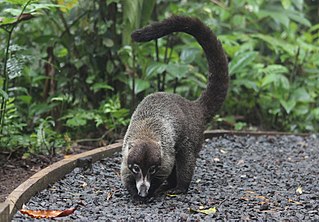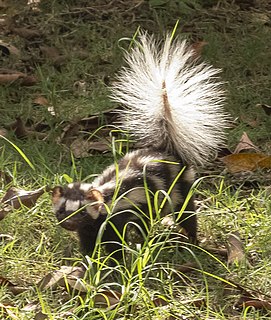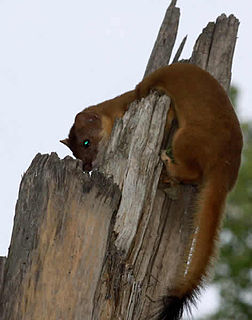 W
WThe genus Bassaricyon consists of small Neotropical procyonids, popularly known as olingos. They are native to the rainforests of Central and South America from Nicaragua to Peru. They are arboreal and nocturnal, and live at elevations from sea level to 2,750 m. Olingos closely resemble another procyonid, the kinkajou, in morphology and habits, though they lack prehensile tails and extrudable tongues, have more extended muzzles, and possess anal scent glands. However, the two genera are not sisters. They also resemble galagos and certain lemurs.
 W
WThe cacomistle is a nocturnal, arboreal and omnivorous member of the carnivoran family Procyonidae. Its preferred habitats are wet, tropical, evergreen woodlands and mountain forests, though seasonally it will venture into drier deciduous forests.
 W
WThe Caribbean monk seal, West Indian seal or sea wolf was a species of seal native to the Saint Kitts and Nevis, and is now believed to be extinct. The Caribbean monk seals' main predators were sharks and humans. Overhunting of the seals for oil, and overfishing of their food sources, are the established reasons for the seals' extinction. The last confirmed sighting of the Caribbean monk seal was in 1952 at Serranilla Bank, between Jamaica and Nicaragua. In 2008, the species was officially declared extinct by the United States, after an exhaustive search for the seals that lasted for about five years. This analysis was conducted by the National Oceanic and Atmospheric Administration and the National Marine Fisheries Service. Caribbean monk seals were closely related to Hawaiian monk seals, which live around the Hawaiian Islands and are now endangered, and Mediterranean monk seals, another endangered species.
 W
WCoatis, also known as coatimundis, are members of the family Procyonidae in the genera Nasua and Nasuella. They are diurnal mammals native to South America, Central America, Mexico, and the southwestern United States. The name coatimundi purportedly derives from the Tupian languages of Brazil.
 W
WThe white-nosed coati, also known as the coatimundi, is a species of coati and a member of the family Procyonidae. Local Spanish names for the species include pizote, antoon, and tejón, depending upon the region. It weighs about 4–6 kg (8.8–13.2 lb). However, males are much larger than females: small females can weigh as little as 2.5 kg (5.5 lb), while large males can weigh as much as 12.2 kg (27 lb). On average, the nose-to-tail length of the species is about 110 cm (3.6 ft) with about half of that being the tail length.
 W
WThe coyote is a species of canine native to North America. It is smaller than its close relative, the wolf, and slightly smaller than the closely related eastern wolf and red wolf. It fills much of the same ecological niche as the golden jackal does in Eurasia. The coyote is larger and more predatory, and was once referred to as the American jackal by a behavioral ecologist. Other historical names for the species include the prairie wolf and the brush wolf.
 W
WThe Cozumel coati, or Cozumel Island coati, is a coati from the Mexican island of Cozumel. It is in the family Procyonidae, which also includes raccoons, olingos, and kinkajous. It has been treated as a species, but the vast majority of recent authorities treat it as a subspecies of the white-nosed coati. Cozumel Island coatis are slightly smaller than the white-nosed coatis of the adjacent mainland ; but, when compared more widely to white-nosed coatis, the difference in size is not as clear. The level of other differences also support its status as a subspecies rather than a separate species.
 W
WThe Cozumel raccoon, also called the pygmy raccoon, is a critically endangered species of island raccoon endemic on Cozumel Island off the coast of the Yucatan Peninsula, Mexico.
 W
WThe bush dog is a canine found in Central and South America. In spite of its extensive range, it is very rare in most areas except in Suriname, Guyana and Peru; it was first identified by Peter Wilhelm Lund from fossils in Brazilian caves and was believed to be extinct. The bush dog is the only living species in the genus Speothos, and genetic evidence suggests that its closest living relative is the maned wolf of central South America or the African wild dog. The species is listed as Near Threatened by the IUCN.
 W
WThe gray fox, or grey fox, is an omnivorous mammal of the family Canidae, widespread throughout North America and Central America. This species and its only congener, the diminutive island fox of the California Channel Islands, are the only living members of the genus Urocyon, which is considered to be the most basal of the living canids. Though it was once the most common fox in the eastern United States, and still is found there, human advancement and deforestation allowed the red fox to become more dominant. The Pacific States still have the gray fox as a dominant. It is the only American canid that can climb trees. Its specific epithet cinereoargenteus means "ashen silver".
 W
WThe greater grison, is a species of mustelid native to Southern Mexico, Central America, and South America.
 W
WThe Javan mongoose or small Indian mongoose is a mongoose species native to South and Southeast Asia that has also been introduced to many regions of the world.
 W
WThe North American jaguar is a jaguar population in North America, from the southwestern United States to Central America. This population has declined over decades.
 W
WThe northern olingo, also known as the bushy-tailed olingo or as simply the olingo, is a tree-dwelling member of the family Procyonidae, which also includes raccoons. It was the first species of olingo to be described, and while it is considered by some authors to be the only genuine olingo species, a recent review of the genus Bassaricyon has shown that there are a total of four olingo species, although two of the former species should now be considered as a part of this species. Its scientific name honors William More Gabb, who collected the first specimen. It is native to Central America.
 W
WThe western lowland olingo is a species of olingo from Central and South America, where it is known from Panama and from Colombia and Ecuador west of the Andes.
 W
WThe neotropical otter or neotropical river otter is an otter species found in Central America, South America and the island of Trinidad. It is physically similar to the northern and southern river otter, which occur directly north and south of this species' range. The length of the neotropical otter can range from 36–66 centimetres (14–26 in), plus a tail of 37–84 centimetres (15–33 in). Body weight ranges from 5–15 kilograms (11–33 lb). Otters are members of the family Mustelidae, the most species-rich family in the order Carnivora.
 W
WThe crab-eating raccoon or South American raccoon is a species of raccoon native to marshy and jungle areas of Central and South America. It is found from Costa Rica south through most areas of South America east of the Andes down to northern Argentina and Uruguay. Despite its name, this species is not restricted to eating only crabs, and the common raccoon also seeks and eats crabs where they are available.
 W
WThe ringtail is a mammal of the raccoon family native to arid regions of North America. It is widely distributed and well adapted to disturbed areas. It has been legally trapped for its fur. It is listed as Least Concern on the IUCN Red List. It is also known as the ringtail cat, ring-tailed cat, miner's cat or bassarisk, and is sometimes called a cacomistle, though this term seems to be more often used to refer to Bassariscus sumichrasti.
 W
WThe American hog-nosed skunk is a species of hog-nosed skunk from Central and North America, and is one of the largest skunks in the world, growing to lengths of up to 2.7 feet (82 cm). Recent work has concluded the western hog-nosed skunk is the same species, and Conepatus leuconotus is the correct name of the merged populations.
 W
WThe hooded skunk is a species of mammal in the family Mephitidae. Mephītis in Latin means "foul odor", μακρός (makrós) in Greek translates to "long" and οὐρά (ourá) translates to "tail".
 W
WThe southern spotted skunk is a species of mammal in the skunk family, (Mephitidae). It ranges from Costa Rica to southern Mexico. At one time this skunk was considered to be a subspecies of the eastern spotted skunk.
 W
WThe striped hog-nosed skunk is a skunk species from Central and South America. This species of skunk is considered a generalist species, because they are able to thrive in, and withstand, disturbed environmental conditions. They can live in a wide range of habitats, including carrasco, arboreal caatinga, mango orchard, and dry forest scrub and occasionally, in rainforest.
 W
WThe spectacled bear, also known as the Andean bear, Andean short-faced bear, or mountain bear and locally as jukumari, ukumari (Quechua) or ukuku, is the last remaining short-faced bear. Its closest relatives are the extinct Florida spectacled bear, and the giant short-faced bears of the Middle to Late Pleistocene age. Spectacled bears are the only surviving species of bear native to South America, and the only surviving member of the subfamily Tremarctinae. The species is classified as Vulnerable by the IUCN because of habitat loss.
 W
WThe tayra is an omnivorous animal from the weasel family, native to the Americas. It is the only species in the genus Eira.
 W
WThe long-tailed weasel, also known as the bridled weasel or big stoat, is a species of mustelid distributed from southern Canada throughout all the United States and Mexico, southward through all of Central America and into northern South America. It is distinct from the short-tailed weasel, also known as a "stoat", a close relation that originated in Eurasia and crossed into North America some half million years ago.